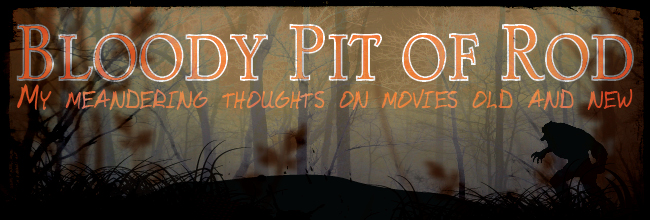The back of the DVD case refers to this film as a
"luridly gothic giallo". Maybe I'm a traditionalist but to me, gialli
are contemporary tales of black-gloved murderers set in urban locales. Perhaps
I've just seen too many films that fit that mold; it seems that to call SEVEN
DEATHS IN A CAT'S EYE a giallo is stretching things a bit. While I'll
concede the film boasts a black-gloved killer with a straight razor fixation,
that detail alone doesn't make it a part of that vicious little sub-genre. To
my perhaps too-picky eye it's more accurately a gothic horror film, and a
pretty entertaining one as well. Director Antonio Margheriti made many Gothics
in his career developing a feel for them that is quite accomplished. Over time
I find myself returning to his work with regualarity and marveling at his
inventivness. One can hear echoes of his earlier efforts from the 1960's in
this film but working in color and on beautiful locations in Scotland he
breathes some real freshness into the scenario. SEVEN DEATHS IN A CAT'S
EYE has all the great qualities (murder mystery, gorgeous ladies, etc.)
and flaws (slow pace, logic lapses) that most Gothics share, with a few strange
things added to rattle the bars on the cage. While at least one idea thrown
into the mix seems pointless, I can't complain too much about a film that
involves both a lesbian and a violent orangutan!
The film is set in and around a large Scottish castle named
Dragonstone. The story begins with an anonymous man being killed in the castle
by an unseen assailant. His body is dumped in the cavernous cellar where rats
immediately start devouring his face. Dragonstone is the ancestral home of the
MacGrieff family, but the current Lady MacGrieff (Francoise Christophe) is
having trouble maintaining the place. She's just been rebuffed in an attempt to
get financial help from visiting relative Lady Alicia (Dana Ghia) when the
unexpected arrival of Alicia's young daughter Corringa (the lovely Jane Birkin)
changes Lady MacGrieff's plans. Hoping for a romantic match between her son
Lord James MacGrieff (Hiram Keller) and the beautiful Corringa, she plots to
bring them together. James is a recluse who purportedly killed his baby sister
when a child and has been kept a virtual prisoner in Dragonstone his entire
life. James' sensitive side is shown by his hobby of painting and in his choice
of pet — an oversized orangutan bought from a passing circus. This poor creature
has a violent streak and has somehow gotten out of its cage recently. Hmmmm... An
embittered man who resents his status as a virtual prisoner in his own home,
Lord MacGrieff demonstrates his anger one evening by insulting most of his
mother's dinner guests. The only person who seems to be able to get any respect
from James is the newly arrived village priest (Venantino Venantini). The
object of most of the lord's vitriol is his personal doctor-in-residence, Franz
(Anton Diffring). He has the dual responsibility of treating James' supposed
madness and serving as Lady MacGrieff's lover. Franz routinely beds her but
also keeps regular appointments with Suzanne, the sexy "French
teacher" originally brought to Dragonstone to entice James to produce an
heir.
Lady Alicia's response to Lord MacGrieff's dinnertime rudeness is to make swift plans for she and Corringa to leave the castle, but that night someone slips into Alicia's bedroom and smothers her. Lady MacGreiff convinces Franz to falsify the death certificate even as both of them claim to be ignorant of who murdered the woman. Hmmmmm... Corringa has been amused since childhood by tales of the family curse, which states that any MacGrieff killed by one of the same blood will return as a vampire to exact revenge. But when her mother's coffin is discovered ripped apart and her body missing, she begins to fear that the curse may be more than just a bedtime story. Soon servants are being killed by a razor-wielding murderer, cousins James and Corringa are writhing in bed together, the orangutan is loose and the police are stumbling around trying to solve the murders.
Seven Deaths juggles a myriad of characters and ideas in an attempt to maintain interest and it succeeds pretty darned well. The red herrings fly by with just enough emphasis to keep each stuck in the memory, while a hint of strangeness is added by having the same fluffy housecat witness each murder. The presence of the cat soon becomes the herald of impending violent death which, of course, makes the proceedings even more entertaining. Indeed, I can easily imagine a drinking game centered on the cat's appearances throughout the movie. Drunkenness would be the eventual outcome.
The film plays skillfully with the standard gothic tropes,
including bringing the often subtextual (and just as often pointless)
lesbianism out a bit more than usual. The script doesn't have a lot of fresh
ideas but handles them well enough to keep a sharp viewer on his toes.
Scattered around is some nicely turned dialog and some good performances,
giving one a pretty clever Gothic with a completely unsolvable mystery at its
core. Damned good fun! Working in a genre in which he was well versed allows
Margheriti to play with using the widescreen canvas to good effect; he really
piles on the colored gels in his lighting designs. No chance for primary
lighting is missed, whether it is sunlight passing through stained glass
windows or a multicolored lampshade casting rainbow shadows around dark rooms.
For a giallo or a Gothic fan this is a must see!













No comments:
Post a Comment